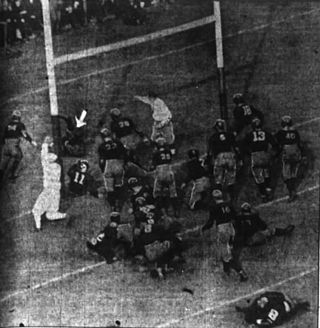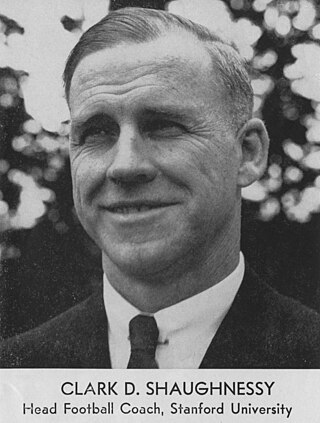
The 1922 college football season had a number of unbeaten and untied teams, and no clear-cut champion, with the Official NCAA Division I Football Records Book listing California, Cornell, Iowa, Princeton, and Vanderbilt as national champions. California, Cornell, and Princeton were all picked by multiple selectors.
The 1949 Rose Bowl was the 35th edition of the college football bowl game, played at the Rose Bowl in Pasadena, California, on Saturday, January 1. The seventh-ranked Northwestern Wildcats of the Big Nine Conference defeated the #4 California Golden Bears, champions of the Pacific Coast Conference, 20–14.
The 1982 Stanford Cardinal football team represented Stanford University in the Pacific-10 Conference in the 1982 NCAA Division I-A football season. Led by third-year head coach Paul Wiggin, the Cardinal had an overall record of 5–6.
The 1972 Rose Bowl was the 58th edition of the college football bowl game, played at the Rose Bowl in Pasadena, California, on Saturday, January 1. The Stanford Indians of the Pacific-8 Conference upset the undefeated and fourth-ranked Michigan Wolverines of the Big Ten Conference by a point, 13–12, repeating as Rose Bowl champions. The Player of the Game was Stanford quarterback Don Bunce.

The 1940 Stanford Indians football team, nicknamed the "Wow Boys", represented Stanford University as a member of the Pacific Coast Conference (PCC) during the 1940 college football season. First-year head coach Clark Shaughnessy inherited a team that finished with a 1–7–1 record the previous season. He installed his own version of the T formation, a system that had largely fallen into disuse since the 1890s and was viewed as obsolete. The Indians shocked observers when they won all ten of their games including the Rose Bowl, which prompted several selectors to declare them the 1940 national champions. Stanford's dramatic reversal of fortunes prompted football programs across the nation to abandon the single-wing formation in favor of the new T formation.

The 1925 Alabama Crimson Tide football team represented the University of Alabama in the 1925 Southern Conference football season. It was the Crimson Tide's 32nd overall and 4th season as a member of the Southern Conference (SoCon). The team was led by head coach Wallace Wade, in his third year, and played their home games at Denny Field in Tuscaloosa, at Rickwood Field in Birmingham and at the Cramton Bowl in Montgomery, Alabama. They finished the season with their first ever perfect record, as Southern Conference champions, defeated Washington in the Rose Bowl, and were retroactively named as national champion for 1925 by several major selectors.
The 1926 Alabama Crimson Tide football team represented the University of Alabama in the 1926 college football season. It was the Crimson Tide's 33rd overall and 5th season as a member of the Southern Conference (SoCon). The team was led by head coach Wallace Wade, in his fourth year, and played their home games at Denny Field in Tuscaloosa, at Rickwood Field in Birmingham and at the Cramton Bowl in Montgomery, Alabama. They finished the season with a record of nine wins, zero losses and one tie, as Southern Conference champions. They tied undefeated Stanford in the Rose Bowl. The 1926 Alabama team was retroactively named as the 1926 national champion by Berryman QPRS, Billingsley Report, College Football Researchers Association, and Poling System, and as a co-national champion by the Helms Athletic Foundation and National Championship Foundation. The team was ranked No. 9 in the nation in the Dickinson System ratings released in December 1926.
The 1934 Alabama Crimson Tide football team represented the University of Alabama in the 1934 college football season. It was the Crimson Tide's 41st overall season and 2nd as a member of the Southeastern Conference (SEC). The team was led by head coach Frank Thomas, in his fourth year, and played their home games at Denny Stadium in Tuscaloosa, Legion Field in Birmingham and the Cramton Bowl in Montgomery, Alabama. They finished the season with a perfect record, as Southeastern Conference champions for the second consecutive season and defeated Stanford in the Rose Bowl.

The 1926 Stanford Indians football team was an American football team that represented Stanford University in the Pacific Coast Conference (PCC) during the 1926 college football season. In head coach Pop Warner's third season at Stanford, the team compiled a 10–0 record during the regular season, outscored its opponents by a total of 261 to 66, and won the PCC championship. Stanford then faced undefeated Alabama in the 1927 Rose Bowl, which ended in a 7–7 tie.

The 1941 Stanford Indians football team represented Stanford University as a member of the Pacific Coast Conference (PCC) during the 1941 college football season. Second-year head coach Clark Shaughnessy led the team to a 6–3 record. Before the season, Stanford, which the year prior had finished 10–0, was considered a favorite for the national championship, but three conference losses put it out of contention for a return to the Rose Bowl. After the season, Shaughnessy left Stanford to take over as head coach at the University of Maryland.
The 1951 Stanford Indians football team represented Stanford University in the 1951 college football season. Stanford was led by first-year head coach Chuck Taylor. The team was a member of the Pacific Coast Conference and played their home games at Stanford Stadium in Stanford, California.
The 1971 Stanford Indians football team represented Stanford University during the 1971 NCAA University Division football season. Led by ninth-year head coach John Ralston, the Indians were 8–3 in the regular season and repeated as Pacific-8 Conference champions at 6–1.
The 1966 Stanford Indians football team represented Stanford University during the 1966 NCAA University Division football season. The Indians were coached by John Ralston in his fourth season. The team was 4–1 outside their conference, but won only one conference game, defeating rival California for the sixth straight season, establishing the longest winning streak by one team in the Big Game until the 2001 Stanford team surpassed the record.
The 1927 Stanford football team represented Stanford University in the 1927 college football season. In head coach Pop Warner's fourth season, Stanford was undefeated in the Pacific Coast Conference, with a tie in the game against USC. With a three-way tie for the conference championship, Stanford was chosen to represent the conference in the 1928 Rose Bowl against Pittsburgh, with Stanford winning its first Rose Bowl in its fourth attempt, 7–6.
The 1937 Stanford Indians football team represented Stanford University as a member of the Pacific Coast Conference (PCC) during the 1937 college football season. Led by fifth-year head coach Claude E. Thornhill, the Indians compiled an overall record of 4–3–2 with a mark of 4–2–1 in conference play, placing second in the PCC. The team played home games at Stanford Stadium in Stanford, California.
The 1949 California Golden Bears football team was an American football team that represented the University of California, Berkeley in the Pacific Coast Conference (PCC) during the 1949 college football season. In their third year under head coach Pappy Waldorf, the Golden Bears compiled a 10–1 record, won a second straight conference title, lost to Ohio State in the Rose Bowl, and outscored its opponents 319 to 131. Home games were played on campus at California Memorial Stadium in Berkeley, California.
The 1948 California Golden Bears football team was an American football team that represented the University of California, Berkeley in the Pacific Coast Conference (PCC) during the 1948 college football season. In their second year under head coach Pappy Waldorf, the Golden Bears compiled a 10–1 record, tied for the PCC championship, lost to Northwestern in the Rose Bowl, and outscored its opponents 291 to 100. Home games were played on campus at California Memorial Stadium in Berkeley, California.
The 1899 California Golden Bears football team was an American football team that represented the University of California, Berkeley during the 1899 college football season. The team competed as an independent under head coach Garrett Cochran and compiled a record of 7–1–1.
The 1948 Oregon State Beavers football team represented Oregon State College in the Pacific Coast Conference (PCC) during the 1948 college football season. In their fourteenth season under head coach Lon Stiner, the Beavers compiled a 5–4–3 record, defeated Hawaii in the Pineapple Bowl on New Year's Day, and outscored their opponents 249 to 236.
The 1949 Big Nine Conference football season was the 54th season of college football played by the member schools of the Big Nine Conference and was a part of the 1949 college football season.




